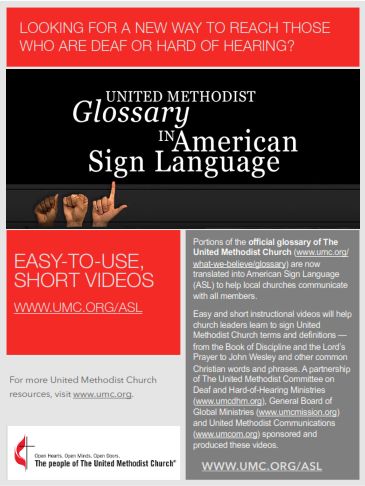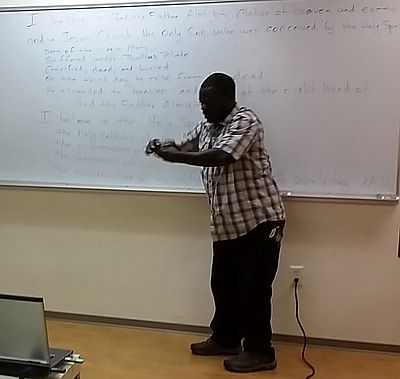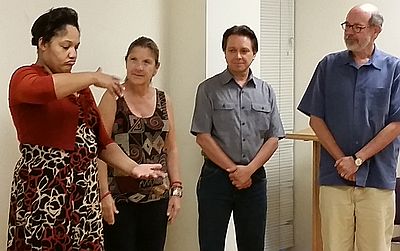The UMC ASL glossary
In August 2015, United Methodist Communications published a series of videos presenting "church" terms in American Sign Language (ASL). The words are from a glossary that explains terms in United Methodist law and usage that are often misunderstood or not known to the general public. This series of videos aims to help United Methodists engage with and welcome Deaf and Hard of Hearing people more effectively. Of the 32,000 United Methodist congregations in the United States, fewer than 200 have accommodations for Deaf people who use ASL.
This work is unique in several ways. It marks the first time that United Methodist Communications has coordinated with Deaf United Methodists to produce information available on the UMC.org website in ASL.
Each video includes sign options and the meaning of the term in American Sign Language. Individuals who are Deaf, communicating in their primary language, present all of the terms. All terms are ASL translations of the glossary, as defined by The United Methodist Church.
A diverse team of American Sign Language users, both Deaf and hearing, compiled the translations. The team included United Methodist seminary graduates, native ASL users and professional ASL interpreters.
Bringing American Sign Language to UMC.org makes possible language access to United Methodist teachings and materials directly in ASL. This is significant step toward opening United Methodist church doors to individuals who communicate in ASL.
The initial phase was published with translations from the United Methodist glossary. It was funded in part by a grant issued by the Deaf Ministry Fund. The Deaf Ministry committee is part of the Global Health unit of the General Board of Global Ministries.

Topher Gonzales, LaSaundra Saunders, Leo Yates, Kirk VanGilder, Michelle Provart Menefee, Carol Stevens. Photos by Lisa Jordan.

Topher Gonzales filming at UMCom in Nashville, TN. June 2015.
Playlist at YouTube.
Download a flyer you can share about the project 

Using the ASL glossary in a class setting
Thomas Hudspeth, Lovers Lane UMC
|
At Lovers Lane UMC's Deaf Fellowship class, we used the ASL video for the Apostles' Creed as a resource in teaching a class.
First, we showed the ASL video of the Apostles' Creed on the video website. Then, the leader asked the people what they saw, asking clarifying questions and feedback. Then the leader wrote the English text of the Apostles ' Creed on a whiteboard. The class was divided into smaller groups of combined Hearing and Deaf persons, about 5 to 6 people in each group. |

|
The class was asked to imagine themselves in another country, where a group of Deaf people noticed a cross on your necklace. With the ground rule that the Deaf in that country do not know ASL, and that you don't know the local sign language, participants were told to use gestures, and tell the local deaf people about the Christian faith, based on the Apostles' Creed. We allowed 15 or 20 minutes for the small groups to figure out how to tell the Apostles' Creed in gestures. Having a mix of ASL signers and non-ASL signers in each group, everyone can participate on the same language level. People could point to one phrase of the English text of the Apostles' Creed and use gestures to convey the meaning of the text.
After 15 or 20 minutes, have each group showed their gestures of the Apostles' Creed. We had one Deaf person, who is from another country, who smiled throughout the lesson because she didn't have to know ASL to get the meaning of the Apostles' Creed. And she got to see the Creed communicated by four different groups. Everybody had a great time seeing each others's interpretation in gestures, and I think, a better understanding of the Apostles' Creed. |

|
 umdeaf@gmail.com
umdeaf@gmail.com


